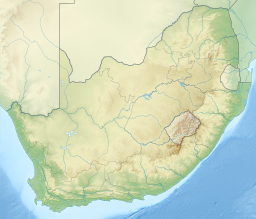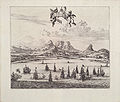| This article needs additional citations for verification. Please help improve this article by adding citations to reliable sources. Unsourced material may be challenged and removed. Find sources: "Table Bay" – news · newspapers · books · scholar · JSTOR (January 2017) (Learn how and when to remove this message) |
| Table Bay | |
|---|---|
| Tafelbaai (Afrikaans) | |
 An aerial view of Table Bay from Bloubergstrand, to the north of Cape Town. Table Mountain is visible in the distance on the far side of the bay. An aerial view of Table Bay from Bloubergstrand, to the north of Cape Town. Table Mountain is visible in the distance on the far side of the bay. | |
 | |
| Coordinates | 33°51′S 18°27′E / 33.850°S 18.450°E / -33.850; 18.450 |
| Ocean/sea sources | Southern Atlantic Ocean |
| Basin countries | South Africa |
| Islands | Robben Island |
| Settlements | Cape Town |
Table Bay (Afrikaans: Tafelbaai) is a natural bay on the Atlantic Ocean overlooked by Cape Town (founded 1652 by Van Riebeeck) and is at the northern end of the Cape Peninsula, which stretches south to the Cape of Good Hope. It was named because it is dominated by the flat-topped Table Mountain.
 Table Bay, the harbour and the City Bowl from the summit of Table Mountain in 2022.
Table Bay, the harbour and the City Bowl from the summit of Table Mountain in 2022.
History
Bartolomeu Dias was the first European to explore this region in 1486. The bay, although famous for centuries as a haven for ships, is actually a rather poor natural harbour and is exposed to storm waves from the northwest. Many sailing ships seeking refuge in the bay during the 17th and 18th centuries were driven ashore by winter storms.
The Dutch colonists nevertheless persisted with their efforts on the shores of Table Bay, because good natural harbours along this coastline are almost non-existent. The best of them, Saldanha Bay, lacked fresh water. Simon's Bay was well protected from westerly winter storms and swells, but more exposed to summer southeasterly storms and difficult to access overland from Cape Town. Hout Bay was small and exposed to the prevailing southwesterly swell. Eventually a harbour was built in Table Bay by a process of land reclamation and was protected from storm waves by breakwaters. The older part of this development is called the Victoria Dock; the newer part, the Duncan Dock. Robben Island, where Nelson Mandela was imprisoned for decades, is in this bay.
The bay's beaches were oiled following an accident involving the Dutch tanker Sliedrecht in November 1953. The vessel moved 96 km (60 mi) offshore to pump out 1,000 tonnes of oil that had been fouled with seawater after the initial impact.
Image gallery
-
 Dutch ships off Table Bay in the 17th century
Dutch ships off Table Bay in the 17th century
-
 Looking over sailing ships in Table Bay in 1727 with Table Mountain in the background
Looking over sailing ships in Table Bay in 1727 with Table Mountain in the background
-
 Map of Table Bay (1882)
Map of Table Bay (1882)
-
 Map of the Docks and Infrastructure (1884)
Map of the Docks and Infrastructure (1884)
-
 Cape Town from space, looking south over False Bay with Hangklip Point (top left), Cape Point (top right) and Table Bay south and east of the clearly visible, circular Robben Island, February 1995.
Cape Town from space, looking south over False Bay with Hangklip Point (top left), Cape Point (top right) and Table Bay south and east of the clearly visible, circular Robben Island, February 1995.
-
 Synthetic perspective with 2× exaggerated elevation, from satellite elevation and image data. Looking east over Cape Peninsula and False Bay (behind) with Robben Island (front left), Table Mountain (centre front) and Cape Point (front right).
Synthetic perspective with 2× exaggerated elevation, from satellite elevation and image data. Looking east over Cape Peninsula and False Bay (behind) with Robben Island (front left), Table Mountain (centre front) and Cape Point (front right).
-
 Sketch of Cape Town from the East India Company Ship Defense, en route from the Downs to Bombay, anchored in Table Bay on January 24, 1739.
Sketch of Cape Town from the East India Company Ship Defense, en route from the Downs to Bombay, anchored in Table Bay on January 24, 1739.
See also
References
- "Ship Oil Kills Fish, Penguins". Newcastle Sun (NSW : 1918 - 1954). 1953-11-03. p. 8. Archived from the original on 2021-03-21. Retrieved 2020-04-22.
| African seas | |
|---|---|
| Oceans and seas | |
| Gulfs and bays |
|
| Straits | |
| Historical seas | |